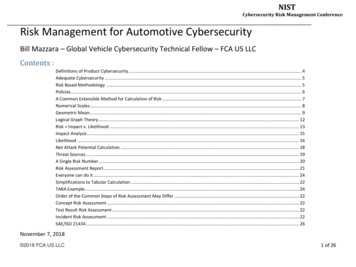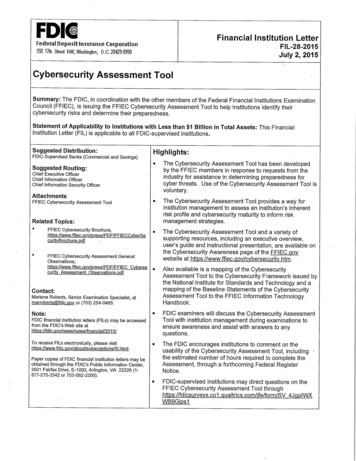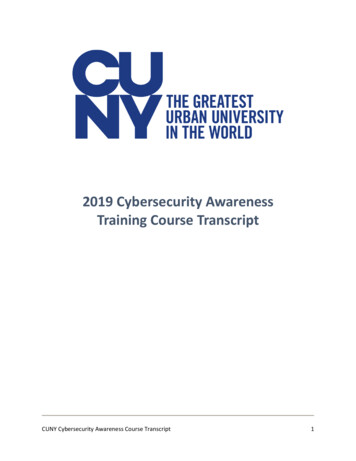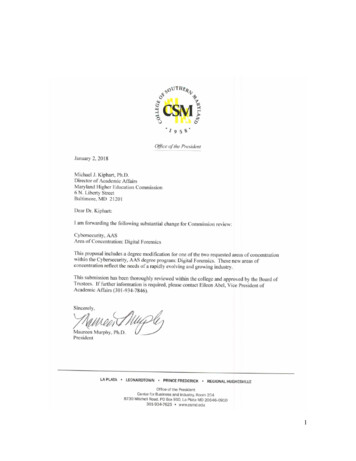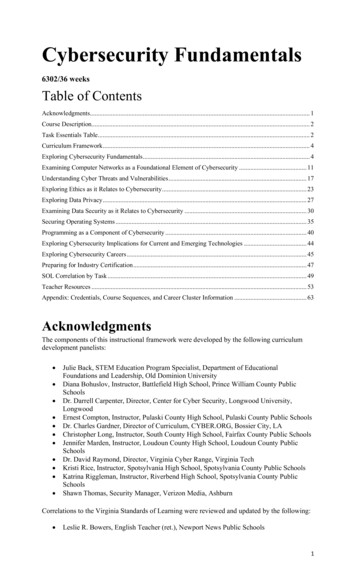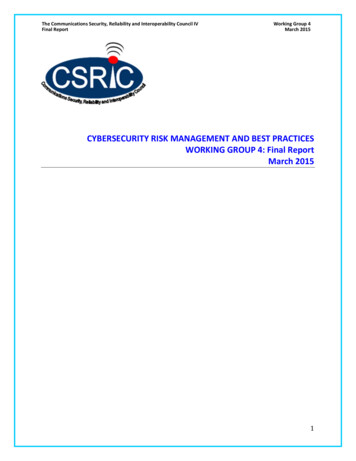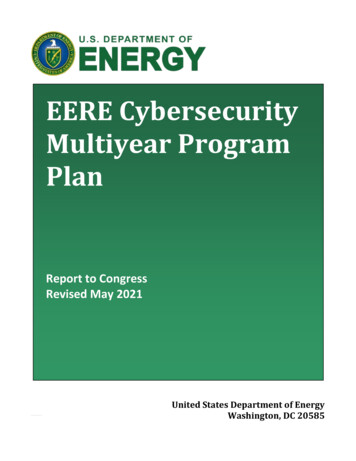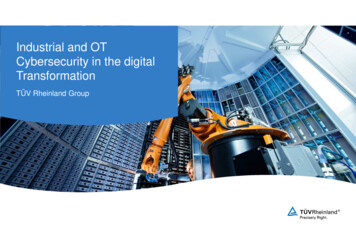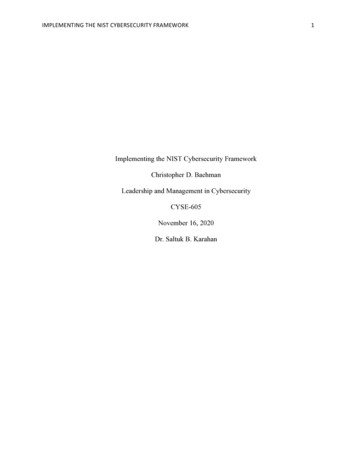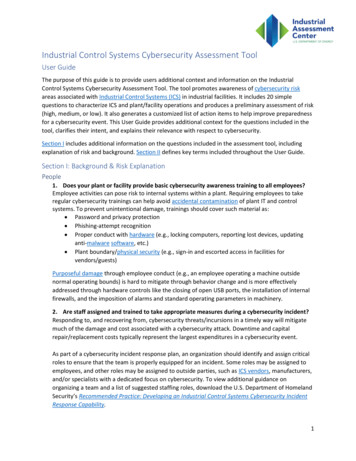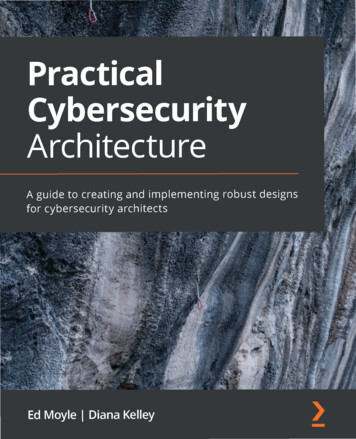
Transcription
PracticalCybersecurityArchitectureA guide to creating and implementing robust designsfor cybersecurity architectsEd MoyleDiana KelleyBIRMINGHAM—MUMBAI
Practical Cybersecurity ArchitectureCopyright 2020 Packt PublishingAll rights reserved. No part of this book may be reproduced, stored in a retrieval system,or transmitted in any form or by any means, without the prior written permission of thepublisher, except in the case of brief quotations embedded in critical articles or reviews.Every effort has been made in the preparation of this book to ensure the accuracy of theinformation presented. However, the information contained in this book is sold withoutwarranty, either express or implied. Neither the authors, nor Packt Publishing or itsdealers and distributors, will be held liable for any damages caused or alleged to have beencaused directly or indirectly by this book.Packt Publishing has endeavored to provide trademark information about all of thecompanies and products mentioned in this book by the appropriate use of capitals.However, Packt Publishing cannot guarantee the accuracy of this information.Commissioning Editor: Vijin BorichaAcquisition Editor: Meeta RajaniSenior Editor: Rahul DsouzaContent Development Editor: Alokita AmannaTechnical Editor: Soham AmburleCopy Editor: Safis EditingProject Coordinator: Neil DmelloProofreader: Safis EditingIndexer: Priyanka DhadkeProduction Designer: Shankar KalbhorFirst published: October 2020Production reference: 1221020Published by Packt Publishing Ltd.Livery Place35 Livery StreetBirminghamB3 2PB, UK.ISBN 978-1-83898-992-7www.packt.com
ContributorsAbout the authorsEd Moyle is currently a partner with SecurityCurve. In his 20 years in informationsecurity, Ed has held numerous positions, including Director of Thought Leadershipand Research for ISACA, Senior Security Strategist with Savvis, Senior Manager withCTG, and Vice President and Information Security Officer for Merrill Lynch InvestmentManagers. Ed is a co-author of Cryptographic Libraries for Developers and a frequentcontributor to the information security industry as an author, public speaker, and analyst.Diana Kelley's security career spans over 30 years. She is co-founder and CTO ofSecurityCurve and donates much of her time to volunteer work in the cybersecuritycommunity, including serving on the ACM Ethics and Plagiarism Committee, as CTOand board member at Sightline Security, board member and Inclusion Working Groupchampion at WiCyS, and RSAC US Program Committee. She was the Cybersecurity FieldCTO for Microsoft, Global Executive Security Advisor at IBM Security, GM at Symantec,VP at Burton Group (now Gartner), and a manager at KPMG. She is a sought-afterkeynote speaker, a co-author of the book Cryptographic Libraries for Developers, and oneof Cybersecurity Ventures 100 Fascinating Females Fighting Cybercrime.
About the reviewerG. Colin Campbell has been working in the information technology and cybersecurityfields for 25 years, focused in particular on building and testing secure corporateinfrastructure. He has worked as a consultant with clients at all levels, but has focusedon financial services companies in recent years. Within companies, Colin has managedbusiness continuity, penetration testing, log management, and other associated disciplines.He is passionate about security inside and outside of corporate organizations and has ledbasic computer security seminars for users at all levels.I'd like to thank the Packt Publishing team for the opportunity to reviewand contribute to this book. I'd also like to thank my wife and son forallowing me to sacrifice some time outside of work hours to let me help withthis project.Packt is searching for authors like youIf you're interested in becoming an author for Packt, please visit authors.packtpub.com and apply today. We have worked with thousands of developers andtech professionals, just like you, to help them share their insight with the global techcommunity. You can make a general application, apply for a specific hot topic that we arerecruiting an author for, or submit your own idea.
2The Core of SolutionBuildingIn the first chapter of this book, we went through what a cybersecurity architect is, whatthey do (that is, the functions they perform), and the value they – and the architectureprocess itself – can provide to an organization. In this chapter, we will build on that tobegin the process of describing how to develop an architecture.Over the course of this chapter, we will explore the structures that organizations set upto ensure key outcomes are achieved. It is important for the architect to understand theseelements because the whole point of architecture is to support the organizational mission– to do that, we have to understand what that mission is and the strategies that theorganization has put in place to achieve it. This will be the backdrop to all the work we do.We'll walk through how organizations derive their goals (including security goals), andstrategies they will use to ensure those goals are being met and that resources are usedoptimally in support of them. We'll go through the structures (that is, the processes,documentation, and technology systems) that organizations use to ensure that thesethings are happening and that strategies to realize goals are performing as expected.Lastly, we'll walk through a process that you can use to tailor such an organization-specific"backdrop," custom to your organization, which you will use as context and a guide foryour architecture efforts.
52The Core of Solution BuildingWe'll achieve this by working through the following topics: Terminology Understanding solution building Establishing the context for designs Understanding goals Structures and documents Risk management and compliance Establishing a guiding processTerminologyBefore we dive into the meat of this chapter, the first thing we should note is that wehave made the conscious decision to use terminology that will be most immediatelytransparent and accessible to all readers. This, however, will not always be the exactsame terminology used by many of the security architecture frameworks, standards, andguidance that you may encounter.For example, one of the most important concepts in this section is understanding thegoals of the organization and mapping those goals to security outcomes and principles,as we stated previously. It is quite literally the case that any security effort, whetherarchitecture, operations, incident response, or any other discipline within security, existssolely to help enable the organization to fulfill its mission. In the case of a for-profit entity,such as a company, this might mean being profitable or providing value to shareholders.In the case of a philanthropic organization, it might mean providing value to thecommunities it serves. In government, this might mean providing public services tocitizens and ensuring transparency. In short, it's whatever is important to the organizationto be successful at whatever its mission is.Formally, this process of ensuring that resources are used in support of the organization'sgoals and mission is what many frameworks and standards mean when they use the word"governance." In fact, many frameworks and standardized approaches (both for technicalarchitecture and otherwise) start from the point of view of "governance" used with thismeaning.
Terminology53There are a few problems with this, however: The first problem is that not all of the frameworks use this same language – or useit in the same way. For example, the concept of understanding the organization'sgoals is important in all of them (they have to be for the reasons that we outlined),but they don't all use consistent language to refer to it. For example, O-ESA usesthe formal sense of the word "governance" (The Open Group, Open EnterpriseSecurity Architecture (O-ESA): A framework and template for policy-driven security,Van Haren. Zaltbommel). OSA uses the word governance too, but instead uses itas a specific component of the overall "security architecture landscape" (althoughnote that the source material implies a slightly broader definition of the word thanthat outlined by O-ESA) ations/osa-landscape). SABSA, by contrast, prefersthe language of "business enablement"(John Sherwood et al, Enterprise SecurityArchitecture: A business-driven approach, CRC Press). The second problem is that the word "governance" itself is one that can be useddifferently by different people. Sometimes, though not often, it is used in theformal way we described previously. More commonly, it is used in other ways. Forexample, one person might use the term to refer to the organizational model of anorganization (for example, the board of directors provides corporate governance),another in reference to a political body or national government (the governance of anation), yet a third in the formal sense that O-ESA and TOGAF mean it (technologygovernance), and someone else to refer to influence or control (the king's governanceover their realm).These factors mean that reasonable people talking to each other can easily speak at crosspurposes about this topic in a way that leads to misunderstanding. It is critical to thearchitecture process that we minimize the likelihood of being misunderstood. In fact, aswe go through this book, you will see that communication is probably among the mostimportant (if not the most important) skills that an architect can have. We will wantto be well understood by others we work with, and we want to make sure that we arewell understood by you. It is frankly a hard-enough exercise to get right without usinglanguage that engenders or lends itself to miscommunication.Therefore, we've chosen language that we hope is unambiguous throughout. If we meanenabling the mission of the organization, we will say that. We will attempt to avoid terms(such as "governance") that might be potentially ambiguous, even when that sameterminology is used differently elsewhere outside of this book.
54The Core of Solution BuildingWhile this is advantageous to us in conveying the concepts clearly to you here and now,we wanted to be clear from the get-go that we're doing this. Why? Because it can get youin trouble if you look in other sources and see the same concepts being referred to in otherways. Should you decide to look into other architectural materials and methods, keep inmind that the same concepts can be conveyed in different ways and that, depending onwhich material you are leveraging, some of them might use different terms than those weare employing here.Understanding solution buildingIn order to get started developing a cybersecurity architecture, we need to gather a fewraw materials first. These are the items that will set the context for all the design work thatwe will undertake in subsequent chapters. Specifically, we need to first obtain a baselineunderstanding of the organization itself; this helps ensure that the measures we will laterincorporate into designs are appropriate, practicable, and in line with the context. Thisis, in turn, because the nuances and specifics of the organization – everything from itsgoals, to its culture, to its "mission" and unique needs – will ultimately drive the design.Everything about the design – the scope, security measures, implementation, operationalconstraints, and functional requirements – must account for the context in which it willoperate. That context is an extension of the organization itself.As an example of what we mean here, consider a situation where you decide to plana fishing trip. There are a lot of tasks you'd need to complete to do so, and severalimportant decisions that you'd need to make along the way. Specifically, you'd need todo the following: Acquire the appropriate equipment (tackle, bait, fishing rods, and so on). Acquire any provisions that you'd need (food, beverages, hot or cold weatherclothing, and so on). Organize secure lodging and travel arrangements. Depending on the type of fishing you want to do, you may need to secure a boat,and specialized equipment such as drills (ice fishing), depth finders or radar(deep water fishing), and lights (night fishing).
Understanding solution building55Each of the decisions you make impacts the experience. Some will impact the finalexperience more than others, but each individual decision will impact the outcome;and, obviously, you need to make decisions in a particular order. These and other factorsgovern the circumstances under which your decision making and preparation makesense – and without them, you have every likelihood of making a wrong assumption,resulting in wasted planning time, wasted money, and bringing about a sub-optimalexperience for all involved.One way to think about it is by drawing an analogy with the laws of physics that governhow our universe operates. We know that light moves at a constant speed in a vacuum(c 299,792,458 m/s). We know that the force between two bodies is governed by theproduct of their masses over the square of the distance between them multiplied by thegravitational constant (G 6.67384(80) 10 11 kg 1 m3 s 2). But what would the universebe like if these values were subtly different?It'd be totally different – fundamentally different. Even a small change to the underlyinglaws and parameters of the universe would result in a vastly different universe. If thespeed of light were faster, (aside from other more pronounced effects) it would impactmagnetism, perhaps leading to an earth without magnetic poles (see her for more details). If the gravitationalconstant were subtly smaller or larger, the universe as we know it couldn't exist at all. Allthese values define the context of what we can perceive in the universe.The point is, even a very small change to the underlying "context" means something totallydifferent – and a minor change at that most basic level means outcomes that are vastlyand fundamentally different from each other. Just like the structure of the universe wouldbe vastly different with even a minute tweak to the underlying constants of gravitationand speed of light, so too will designs that are viable – even optimal – in one organizationbe total non-starters in others based on the fundamental assumptions and drivers uponwhich the business is built. A minor, subtle difference, misunderstanding, or "tweak" ofthe most fundamental contextual parameters means a completely different outcome andset of constraints. As architects, therefore, it is up to us to identify, understand, and abideby these fundamental assumptions that govern the world in which we will operate.
56The Core of Solution BuildingThere are the "laws" that govern how your cybersecurity architecture "universe" operatesthat are just like this: contextual information that governs each decision that we'll make.These represent the fundamental assumptions and constraints under which designdecisions make sense and are viable. If you've been in an organization for a period oftime, many of them are likely to be so ingrained to you as to be relatively invisible. Forexample, if I've spent my whole career as a software developer working in a shop that dealsexclusively in writing Java code, it might not occur to me that it might be advantageous towrite in Python.Either way, we need to know what these things are so that we can design around them andensure that the designs we're proposing make sense for the organization into which they'llbe deployed.Establishing the context for designs"Bosch (the power tools company) was addressing how to market theirproducts. They started to examine how they market and how they might doit better. They realized in the course of that that they don't provide "drills,"they provide the capability to rapidly and reliably make holes of a certaindepth, width, and quality. What their customers want is to make holes: thedrill is just a tool to get them there. This way of looking at capability carriesacross to technology: the "why" isn't about the technology – it's insteadabout the business capability. This is what's most important."– John Sherwood, chief architect, thought leader, and co-founder of TheSABSA InstituteThis section is all about identifying, breaking down, and systematically cataloging thefundamental assumptions, design constraints, and other immutable factors that willgovern what designs are possible. In other words, it's about laying out the "universal laws"that will govern how designs must operate.Believe it or not, this is uniquely important to the design process. The Roman architectMarcus Vitruvius Pollio, in his seminal 20-volume work De architecture (Of architecture),set out three fundamental principles of architecture (see Hicky Morris Morgan, translator.Vitruvius: The Ten Books on Architecture, by Marcus Vitruvius Pollio, Harvard UniversityPress): Firmatis (durability) Utilitas (utility) Venustatis (beauty)
Establishing the context for designs57These principles are as valid to us today as they were 2,000 years ago when the book waswritten. They are also almost entirely dictated by the context in which the structure(in our case, the structure of the security mechanisms safeguarding our organization) willbe employed. For our purposes, we will be most concerned with the first two of Vitruvius'principles (durability and utility) – both of these are tightly bound to the organizationsince the "durability" of the solution will vary depending on the context within which thesolution will operate, and "utility" will depend on how the solution will be employed andhow best it meets the needs of those using it.This chapter will therefore focus on establishing the context for your designs. To do this,we will start by outlining the three most critical areas that will influence your planning: Organizational goals Existing structures and documents Risk management and complianceThe first item, organizational goals, is really what defines this chapter, meaning if there'sone single thing that is most critical to architecture design, it's this: the organization'sgoals. Understanding the goals is necessary because it is key to understanding what isimportant to the organization, and this in turn informs us what – and how – to defendto best ensure those goals are met.If it were practical to do so, we might stop and look solely and exclusively at the goals ofthe organization as the single, pure, and unerring contextual framework upon which wewould build our design. This means they would be the only, sole source of informationto guide our design work. We'll explain strategies to do this, but in reality, it is oftennot practical to do it this way, mostly because the time and energy to do so (and do itwell) often eclipses what time we have available. This is because a full mapping of all theenterprise's goals, including extrapolating from them the security requirements that willdictate our architectural planning, can take more time than we usually have availableto us. Therefore, we employ a bit of a "shortcut" in our approach to understand theorganization's goals.That shortcut entails looking at places where goals of the organization may already becodified, implied, or otherwise detailed in some written form. For example, "governancestructures" such as policy, procedures, guidance, and technical standards providea roadmap that we can use to understand better the goals of the organization. Becausethey represent decision points already made by the organization, we can intuit that theyare themselves steeped in – and reflective of – the goals of the organization, but exist ina "pre-rendered" format that we don't have to invest time in to discern.
58The Core of Solution BuildingIn keeping with the approach that we will follow throughout, we will explain the why ofthese items first. Then, once it is clear why we are examining these things, we will explainhow we can use them. By the time we get to the description of how, the process will seem,if not entirely self-evident, at least significantly easier to accomplish than would be thecase if we merely gave you a prescriptive "recipe" to follow.Now that we've established the basic philosophy with which we will approach thischapter, we'll move on to the most important aspect – understanding the goals of thecompany/institution and why they are important when creating security goals.Understanding goals"The most important piece of architecture is to understand the why: why itis that you are doing what it is that you are doing. Understanding the whyleads you to the how. Understand it in the context of the broader businessand organization goals context and let that be the guide to when and howyou implement security."– Ted Ipsen, president and COO of Positroniq, LLCIt is a truism that the work of the architect must start and end with enabling theorganization to accomplish its goals. Security is not an end in and of itself – it doesn'toperate in a vacuum. This means it is only useful in the furtherance of some other goalthat an organization or individual has.You can prove this is the case by considering what security controls you'd use if there nothreats to defend against. For example, would you use antivirus software if malware didn'texist? Would you hire armed guards to protect an empty room? Of course not. Withouta goal – that is, something to protect – security controls have no point.Therefore, security is only useful to the extent that it is attached to some mission that theorganization has: some motivating factor that causes it to be important in the first place.In a business context, the mission (among other things) usually involves the businessbeing competitive, profitable, able to undertake new activities, enabling the workforce,positioning itself the way it wants, and minimizing risk while maximizing opportunity.Other organizations (for example, non-commercial entities) might have different missionsthat are important to them based on what they do, who they are, their context, andnumerous other factors.
Understanding goals59Understanding the mission of the organization is therefore the root from which allsecurity measures and activities spring. Most of us don't think about it in this way often,but we can understand and evaluate the mission of an organization systematically. Bythis, we mean that we can trace each and every security outcome, goal, requirement, andpractice back to the organization's first principles – the mission of the organization andwhy it exists in the first place.There are multiple ways to do this, but one approach is to start with the enterprise goalsand examine them for the success factors or enablers that are required for those goals tobe realized. This means we identify one of many high-level goals, we understand whatthat high-level goal involves (that is, the reason for it), we understand the implementationstrategy of the organization for reaching the goal, and we describe the technology,security, and practical or other factors required for the implementation strategy tosucceed.As an example of what we mean by this, say that I have a goal of learning to play thebagpipes. I can't do that unless certain criteria are met. For example, I'd need someone toteach me; I'd need an instrument to practice on; I'd need a location to practice withoutdisturbing others. If I lived on a desert island (without access to an instructor), if I don'thave an instrument, or if the only available space to practice is in a busy library, there'sfundamentally no path that allows me to achieve the stated goal. In this case, the goal(learning the bagpipes) is supported by multiple success factors that allow it to be possible;those are access to an instructor, an instrument, and a quiet location to practice, inaddition to numerous others that we did not list here.This same principle applies to technology too. Specifically, technology itself is only usefulto the extent that it serves a higher business goal. Would a company invest millions ofdollars in an application that adds no value? No. Would they buy a multi-million-dollarsupercomputer and store it unused in a closet? Also no. Therefore, technology itself is animplementation strategy for making possible a bigger plan that is itself, in turn, a successfactor for a larger business goal. You might refer to this as a "technology goal": a part ofa larger plan that feeds into and supports a business goal.For example, consider Facebook. Facebook as an organization might have the businessgoal of making money. That larger goal is supported by the implementation strategy ofselling advertising on a content-sharing platform. These are true at the broadest level, buthow (specifically) will the organization put it into practice? Crafting an answer spawnsits own new set of goals that are themselves in support of the larger one. For example,one way that the folks at Facebook might conclude that they can achieve the outcomethey want is via advertising sales (economic business goal) as realized by them buildingand providing a website where people can share content with each other (technologyimplementation strategy).
60The Core of Solution BuildingThis website, itself an implementation strategy for the higher-level business, becomes itsown goal (technology goal) supported by implementation strategies of its own (that is, theimplementation that will allow them to create, deliver, and host that website).You'll notice two things about this. First, this technology goal (a website) is only one ofmany possible technology goals that stem from the high-level business goal. There arelikely to be others. In the preceding example of Facebook, you'll notice that there are otherthings they can do to help realize their business goal; they might choose to also have amobile app, acquire other companies such as Instagram, or implement games or othertechnology that ties into their overarching business goal. The specific technology goal(again itself an implementation strategy for the business goal) of "providing a websiteto share content" in turn has its own corresponding success factors and subgoals. Theseget more specific, such as requiring users to have their own space where they can uploadcontent, being able to access the website from a variety of platforms, and so on.These technology goals and success factors branch off yet again to be supported bysecurity goals. Specifically, those security goals support technology by describing thingsthat need to be in place to support the usage of that technology securely. Going backonce again to the Facebook example, providing a user with space to share content meansensuring that only authorized users can access or edit that content. Therefore, we cansee how a security mechanism we're all familiar with (authentication and authorization)supports technology goals directly – and business goals indirectly (that is, by supportingtechnology goals that are themselves supporting larger business goals):Figure 2.1 – Cybersecurity goals derive from business goals
Understanding goals61Starting from the top down, you could map out most, if not all, of the security goals andnecessary functionality that will represent the "universe" of items that are importantto us (security requirements) in our security architecture. By "cascading" each of theorganizational goals to the implementation strategies that support it, and using theresulting subgoals to provide input to the next layer in a pyramid-like fashion, thiswould (should we complete this exercise in its entirety) result in a complete list of all thetechnology and security goals that our architectures will need to support.This is not a new methodology, nor is it unique to this book. Those familiar with itmight recognize that this is a security-focused view into the COBIT 5 "goals cascade"(COBIT 5: A Business Framework for the Governance and Management of Enterprise IT.Pages 17-20. ISACA), which is, in turn, based on research from the University of Antwerp.The goals cascade begins with identifying the high-level business goals of the organization;it derives technology goals from these goals, and then security goals from them. Thismeans that there is a continuous chain from the highest organizational goals down to eachand every technology and security outcome desired to support the organization's mission.To do this systematically, the process implied by COBIT 5 involves (at least theoretically)the following steps:1. Understand enterprise goals.2. Derive organizational success factors (organizational enablers).3. Derive technology goals.4. Derive technology success factors (technology enablers).5. Derive security goals.6. Derive security success factors (security enablers).Now, as you can imagine, you could spend quite a bit of time going through this processcompletely, fully, and thoughtfully for an entire organization. And, in fact, there is benefitin doing so. However, we need to balance completeness and depth of understandingwith realistic practicality and the time we can realistically allot to it. This means such aneffort – to do it well and completely for the level of understanding we need – would takeweeks or even months; for a large organization, it might even take years. This might bea great long-term project if you have infinite time, but we're going to assume that youprobably don't.
62The Core of Solution BuildingInstead, we're going to abbreviate this process somewhat. Specifically, any organizationyou're likely to realistically work with will have documentation already written thatcodifies – or at least implies – many of these things implicitly or explicitly. This meansthere will be some documents (usually in the form of policies, procedures, standards,and
the formal sense of the word "governance" (The Open Group, Open Enterprise Security Architecture (O-ESA): A framework and template for policy-driven security, Van Haren. . Marcus Vitruvius Pollio, in his seminal 20-volume work De architecture (Of architecture), set out three fundamental principles of architecture (see Hicky Morris Morgan, .
